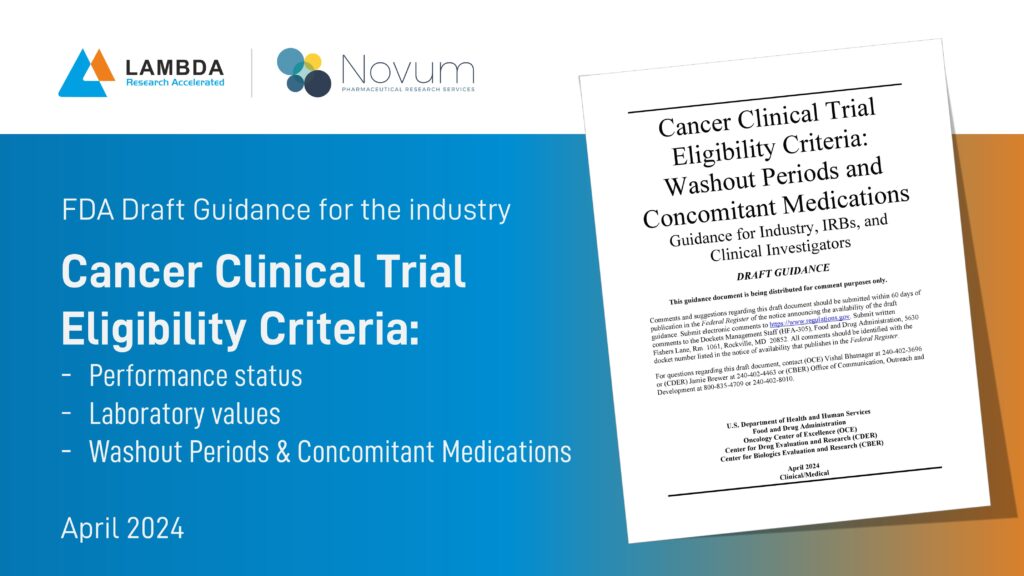In April, the FDA released three new draft guidances on cancer clinical trial eligibility criteria. These address Washout periods and concomitant medications, Performance Status, and Laboratory Values. These guidances build upon concepts introduced in the 2020 guidance “Enhancing the Diversity of Clinical Trial Populations – Eligibility Criteria, Enrollment Practices, and Trial Designs.” They are tailored specifically to cancer clinical trials and aim to improve the representativeness of cancer clinical trial participants.
The core ideas in the new draft guidance documents emphasize that eligibility criteria should be (1) based on scientific data and justified, (2) specific to the trial, the indication, and the investigational therapy, and (3) reviewed throughout the clinical development program as more data becomes available.
Some recommendations from the three new guidance documents include:
- Basing washout periods on known pharmacokinetics/pharmacodynamics (PK/PD) of the previous treatment or clinical/laboratory parameters related to the prior treatment, rather than an arbitrary number of days.
- Excluding concomitant medications only when drug-drug interactions are known or predicted to impact patient safety.
- Modifying either the dosage of the investigational drug or the concomitant medication to allow continued use as needed during the trial.
- Including patients with low-performance status in trials unless a scientific rationale exists for exclusion.
- Considering alternative trial designs when concerns exist about including patients with low-performance status.
- Considering the inclusion of other measures of functional status in trials, such as patient-reported outcomes of physical function and role function or comprehensive geriatric assessment tools.
- Customizing eligibility criteria based on laboratory values to the specific drug and patient population, and reassessing the criteria periodically throughout development as more information is gained.
- Considering allowance of single repeat laboratory tests within a certain time frame, as appropriate.
Some sponsors may resist these recommendations as they may want to use eligibility criteria from trials of other therapies for the same indication to facilitate interpretation and cross-trial comparisons. They may also be reluctant to incorporate broader eligibility criteria that would allow enrollment of more patients with lower performance status or laboratory values indicative of organ dysfunction if they believe that doing so would have a detrimental impact on treatment outcomes.
The practical application of some of these recommendations could prove challenging due to the compression of development timelines by expedited programs. Despite the challenges and limitations, the issuance of these draft guidance documents represents continued progress in the FDA’s ongoing commitment to improving diversity in cancer clinical trials. More inclusive trials provide greater access to novel therapies for patients with cancer and increase the probability that a trial will meet enrollment goals. Importantly, trials with representative participants are more likely to yield clinically meaningful results, with better generalizability to the indicated patient population.
Reference:
- https://www.clinicalleader.com/doc/fda-issues-new-draft-guidances-on-cancer-clinical-trial-eligibility-criteria-0001
- https://www.fda.gov/regulatory-information/search-fda-guidance-documents/cancer-clinical-trial-eligibility-criteria-washout-periods-and-concomitant-medications
- https://www.fda.gov/regulatory-information/search-fda-guidance-documents/cancer-clinical-trial-eligibility-criteria-laboratory-values
- https://www.fda.gov/regulatory-information/search-fda-guidance-documents/cancer-clinical-trial-eligibility-criteria-performance-status




